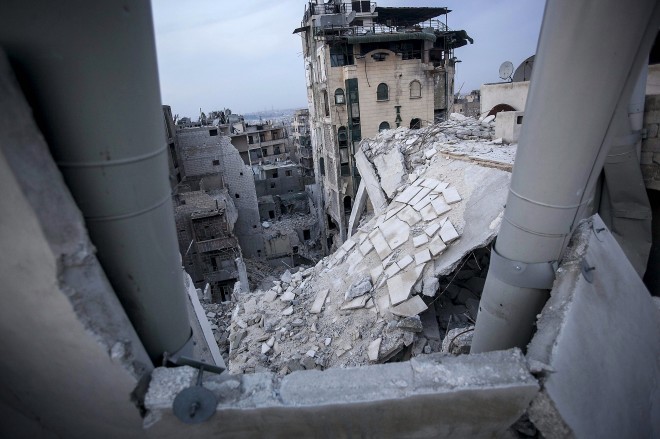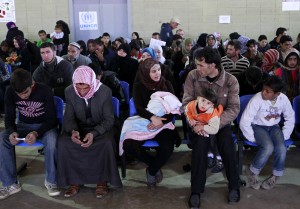Timeline: 3 years of Syrian turmoil

Destroyed buildings, including the Dar Al-Shifa hospital, bottom, lie in ruins following airstrikes in Aleppo, Syria, in this file photo dated Thursday, Nov. 29, 2012. In the summer of 2012 fighting spread to the former commercial capital, Syria’s largest city Aleppo, with rebel forces controlling some neighborhoods, but the battle for overall control continues to this day and much of the city lies in ruins. AP PHOTO/NARCISO CONTRERAS
PARIS—It started as a challenge to Bashar Assad, scrawled in graffiti on a school in a small Syrian border town. Security forces swept into the school and rounded up a handful of boys.
The March 2011 protests to free the teens metastasized, sending Syria into a full blown civil war, complicated by a proxy conflict between Saudi Arabia and Iran, with Cold War overtones thrown in for good measure. More than 120,000 people have died and 2 million have fled their homes.
Syria’s descent into turmoil explains the low expectations for the peace conference in Geneva in a week. In Paris on Sunday, US Secretary of State John Kerry and 10 other foreign ministers are pressuring the opposition to attend the talks.
— March 2011: Protests erupted in Daraa, Syria, over security forces’ detention of a group of boys accused of painting anti-government graffiti on the walls of their school. On March 18, security forces opened fire on a protest in Daraa, killing four people in what activists regard as the first deaths of the uprising. Demonstrations spread, as did the crackdown by President Bashar Assad’s forces.
— June 2011: Police and soldiers in Jisr al-Shughour joined forces with the protesters they were ordered to shoot, and the uprising claimed control of a town for the first time. Elite Syrian troops, tanks and helicopters regained the town within days.
Article continues after this advertisement— August 2011: President Barack Obama called on Assad to resign and ordered Syrian government assets frozen.
Article continues after this advertisement
Syrian families wait to register at the UNHCR center in the northern city of Tripoli, Lebanon, in this file photo dated Wednesday, March 6, 2013. The number of UN-registered refugees topped 1 million in March 2013 and half of them are known to be children, as Syrians flee from their war-ravaged country, and the United Nations’ refugee agency warn that Syria is heading toward a “full-scale disaster.” AP PHOTO/BILAL HUSSEIN
— July 2012: A bombing at the Syrian national security building in Damascus during a high-level government crisis meeting killed four top officials, including Assad’s brother-in-law and the defense minister.
— Summer 2012: Fighting spread to Aleppo, Syria’s largest city and its former commercial capital. Rebels seized control of some neighborhoods, but the battle for control rages to this day and much of the city is in ruins.
— August 2012: Obama said the use of chemical weapons in Syria would be a “red line” that would change his thinking about military action.
— November 2012: The Syrian National Coalition was created, bringing together the main opposition groups. The council was hampered from the outset by crippling infighting and accusations that its members are out-of-touch exiles.
— March 2013: After advancing in the north, rebel forces captured Raqqa, a city of 500,000 on the Euphrates and the first major population center controlled by the opposition. That month, the number of UN-registered refugees topped 1 million, half of them children.
— May-June 2013: Regaining the offensive with the help of thousands of Hezbollah fighters, Assad’s forces recaptured the strategic down of Qusair near Lebanon’s border.
— June 2013: US officials concluded that Assad’s forces had used chemical weapons against the opposition. Obama authorized direct support for the rebels.
— August-September 2013: A chemical weapons attack in the Damascus suburbs killed hundreds. Obama, blaming Assad’s government, said the United States had a responsibility to respond and puts it up to a vote in Congress. Russia proposed instead that Syria give up its chemical weapons, and military strikes were averted.
— September 2013: Eleven rebel groups left the Syrian National Coalition and formed their own alliance intended to create an Islamic state.
— October 2013: Syria destroyed the equipment to produce chemical weapons.
— January 2014: Infighting among rebels, pitting a variety of Islamic groups and moderate factions against the al-Qaida-linked Islamic State of Iraq and the Levant, killed nearly 500 people in a week. The first batch of toxic chemicals was shipped out of Syria.—Lori Hinnant